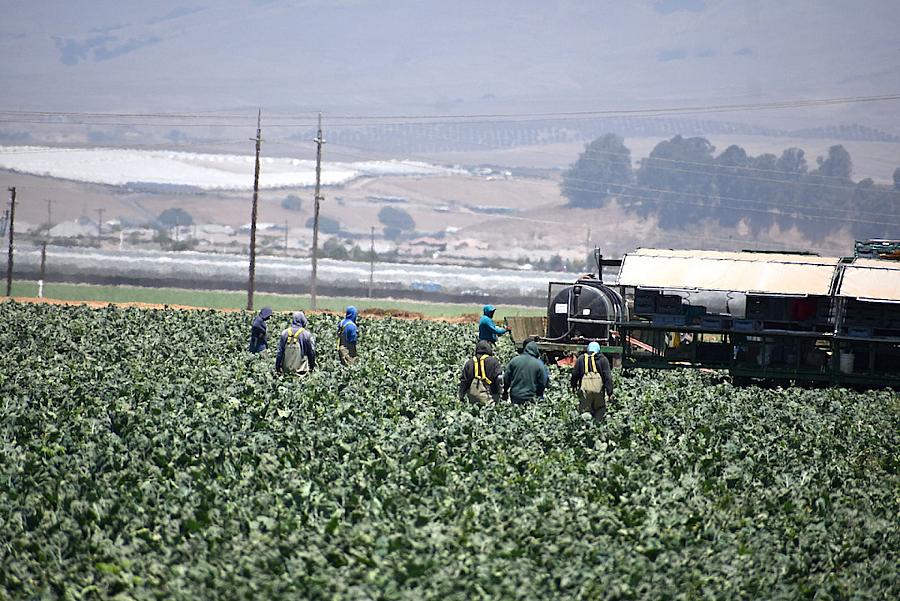What I learned tracking the COVID-19 toll in Santa Barbara County

Agricultural workers in Santa Barbara County.
(Brooke Holland / Noozhawk photo)
When the novel coronavirus began sweeping across Santa Barbara County in the spring and summer of 2020, I wanted to understand who was affected, what was being done, and what was missing from efforts to protect people from the virus.
My resulting reporting project for the 2020 Data Fellowship investigated the devastating toll of novel coronavirus outbreaks in Santa Barbara County skilled nursing facilities and other long-term care facilities, as well as additional stories about what post-vaccination life has been like for older residents at these facilities.
I wanted to help my readers understand how the virus was spread extremely easily at congregate-care and skilled nursing facilities in Santa Barbara County. My efforts included pulling together the data from the state and county, launching an online survey to gather experiences about living, working and visiting local long-term care facilities, interviewing a daughter who lost her father to COVID-19, and directly visiting facilities.
Santa Barbara County reported 170 coronavirus-related deaths connected to a congregate-care facility outbreak, and hundreds of residents and workers at these facilities have tested positive over the past 15 months.
My first story dove into the pandemic’s devastating toll in skilled nursing and congregate-care facilities. My second story looked at outbreak prevention efforts throughout Santa Barbara County, including how county officials helped coordinate staffing resources and COVID-19 testing among skilled nursing workers and residents. My third and fourth stories highlighted how positive cases and deaths dropped dramatically after mass vaccinations, and the post-vaccine realities in these places.
During a monthly fellowship session, Cheryl Phillips, one of my mentors for this project, provided a presentation on fact checking. Her slides on verifying the facts, the data and the quotes stuck with me since I first heard them. Especially her slide with this key lesson: “No surprises. Anyone mentioned in a story, including examples pulled from a dataset, deserves an opportunity to respond.”
During my reporting, I dug into state data on skilled nursing facilities. I looked at COVID-19 positive cases and related deaths, and categories showing the number of beds and beds available for isolation, with a focus on Santa Barbara County’s numbers. I used this database in addition to a congregate outbreak document I got through a public records request from Santa Barbara County.
The state and county data showed which facilities reported large outbreaks among residents and workers, and information obtained through another public records request showed COVID-19-related deaths associated with outbreaks in congregate care settings.
I planned to mention specific facilities in my stories, but some sources were not responding to several interview requests by phone and email. I immediately decided to show up in person at these facilities. I knew that I needed face-to-face meetings, and planned to be transparent about the source of my data. I was determined.
Phillips’ presentation had urged to “go well beyond a simple request for comment — make it clear what the substance of the story is and what you are asking for comment about.”
With my reporter’s notebook, pen and business cards, I arrived at the front doors of at least three Santa Barbara County skilled nursing facilities to arrange the interviews. This was far more successful, and I connected with the appropriate sources for my reporting project.
However, management at one Santa Barbara County skilled nursing facility did not respond to my email, in person and phone requests for comment on my story.
My other investigation focused on the impact of COVID-19 outbreaks among agricultural businesses in the region, and efforts to prevent and contain positive COVID-19 cases. Local agricultural workers have been on the job — in person —during the COVID-19 pandemic, and crowded transportation and workplace environments have increased their risk of contracting the virus.
This two-part series first looked at the community groups who prioritized outreach in multiple languages, including Spanish, and addressed risks of shared transportation, working and living environments for agricultural workers. My final story outlined education, collaboration and outreach to agricultural employers and community organizing groups directly engaged with agricultural workers in the county. This was among the most critical prevention efforts in the fight against COVID-19 in Santa Barbara County. It focused on local community partners that worked together to create targeted COVID-19 testing and vaccination access for farmworkers in Santa Barbara County, as well as a countywide task force that was assembled.
My reporting found that at least 64 agricultural workers have died of COVID-19 since the pandemic arrived in Santa Barbara County in March 2020.
To paint a picture of the county, I decided early on to concentrate my research on key COVID-19 demographic factors among immigrants and indigenous communities, undocumented people and farmworkers. This was based on a conversation I had with a doctoral student in sociology at UC Santa Barbara. He provided me with a valuable collection of databases and studies that could answer several of my questions and helped me better understand the county-level issues that multiple populations face.
Over the past six months, the tips and trove of relevant information that I have learned from senior fellows and guest speakers through this 2020 Data Fellowship will guide my reporting in the future. It has allowed me to dive into topics that haven’t been covered in-depth by local newspapers, and shine a light on subjects that often get overlooked.

